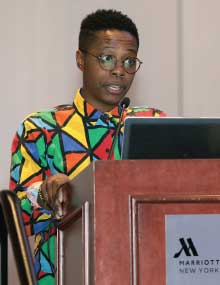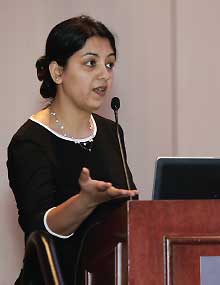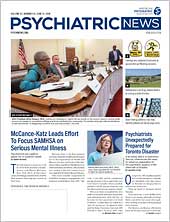Kali Cyrus, M.D., M.P.H., the 2018-2019 APA Jeanne Spurlock Congressional Fellow, faced a number of challenges growing up as female, black, and LGBTQ in the South. She experienced feelings of isolation and anxiety that came with the sense that she did not fit in to any one group. As time went on, though, Cyrus saw positives in her unusual makeup; rather than think of herself as isolated, she had solidarity with multiple groups. Her traits also allowed for more flexibility in adhering to social norms and made interactions with men easier.
“I didn’t have to worry about the same power dynamics as many other professional women,” she said.
Cyrus was one of three women who shared their reflections on the intersectionality of their multiple social identities at APA’s 2018 Annual Meeting in New York last month.
First discussed in the 1980s by civil rights advocate Kimberlȳ Crenshaw, “intersectionality” is a term used to describe overlapping social identities and oppression/discrimination toward those identities. For example, racial/ethnic minority women who identify as LGBTQ may face combined racism, sexism, and homophobia.
The session, sponsored by APA’s Division of Diversity and Health Equity (DDHE), started with an overview of intersectionality by Helena Hansen, M.D., Ph.D., an assistant professor of psychiatry at NYU Langone Health. Hansen referenced pioneers like Crenshaw and Alice Walker, who brought the discussion of intersectionality forward and noted that black women do not simply have to deal with discrimination that is based on either gender or race—they face discrimination as being both black and a woman.
That introduction was followed by the personal accounts of intersectionality, which in addition to Cyrus were presented by Tanuja Gandhi, M.D., also of Yale University and incoming Resident-Fellow Member Trustee on APA’s Board of Trustees; and Tatiana Claridad, a program manager with DDHE. The trio provided their thoughts on how their identities may have shaped perceptions about them, as well as some of their own perceptions of others.
While each shared unique experiences, there were some commonalities, such as feeling stress and anxiety under certain conditions. However, all three women agreed that intersectionality should be embraced.
“We often describe ourselves as either/or,” said Cyrus. “Why can’t it be both/and?”
“As a term, ‘intersectionality’ has been new to me, though some of my favorite authors have talked about these things,” said incoming APA President Altha Stewart, M.D., who closed the session. “For my generation, the concept of intersectionality was bifurcated; we called it bicultural. You had to have a dual identity and be one person at work and then be another at home.”
But in listening to the presenters at that session as well as others in which Stewart had participated that day, she felt times were changing—and for the better.
“I’ve heard from many young people about their thoughts and visions for the future, and today has been a hopeful day,” she said. And in the spirit of the intersectionality session, she provided her own “both/and” identification. “I’m short, Southern, baby boomer, black, female, psychiatrist, SNC (single no children), heterosexual, Catholic convert, city dweller, and extrovert.” ■


